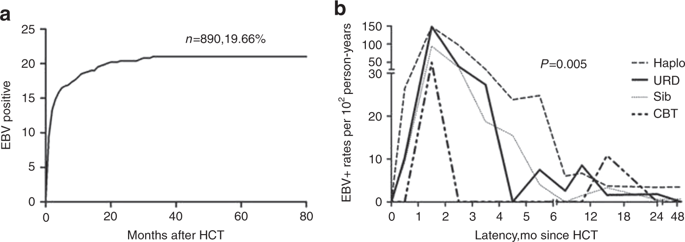Bone Marrow Transplantation ( IF 4.5 ) Pub Date : 2020-02-17 , DOI: 10.1038/s41409-020-0831-7 Yuhua Ru 1, 2, 3 , Xiang Zhang 1, 2, 3 , Tiemei Song 1, 2, 3 , Yiyang Ding 1, 2, 3 , Ziling Zhu 1, 2, 3 , Yi Fan 1, 2, 3 , Yang Xu 1, 2, 3 , Aining Sun 1, 2, 3 , Huiying Qiu 1, 2, 3 , Zhengming Jin 1, 2, 3 , Xiaowen Tang 1, 2, 3 , Yue Han 1, 2, 3 , Zhengzheng Fu 1, 2, 3 , Suning Chen 1, 2, 3 , Xiao Ma 1, 2, 3 , Feng Chen 1, 2, 3 , Jia Chen 1, 2, 3 , Depei Wu 1, 2, 3

|
Epstein–Barr virus (EBV) reactivation after allogeneic hematopoietic cell transplantation (allo-HCT) is one of the major concerns that may lead to fatal EBV diseases. However, updated data are needed because of the remarkable evolution of the HCT protocol and donor selection. We conducted a retrospective study that enrolled 890 allo-HCT recipients. Independent risk factors for EBV reactivation were use of antithymocyte globulin, haploidentical donor, and the presence of chronic graft-versus-host disease. The cumulative incidence of EBV reactivation was 2.9%, 11.7%, 27.3%, and 41.9% for patients with 0, 1, 2, and 3 risk factors, respectively (P < 0.001). Posttransplant lymphoproliferative disorders (PTLDs) occurred in seven patients. EBV reactivation was associated with inferior survival in recipients who survived more than 2 years post-HCT (P < 0.001) but might time-dependently benefit those patients with malignancies by decreasing relapse incidence (P = 0.046). A decreased relapse incidence was observed 1 year after HCT for recipients at first or second remission (P = 0.042) and in the first year post-HCT for recipients with advanced diseases (P = 0.032). We concluded that with current management, PTLDs were efficiently controlled, but EBV reactivation still had a multifactorial impact on transplant outcomes. Multicenter prospective studies are warranted to validate these findings.
中文翻译:

异基因造血干细胞移植后爱泼斯坦-巴尔病毒再激活:对移植结果的多因素影响
异基因造血细胞移植 (allo-HCT) 后爱泼斯坦-巴尔病毒 (EBV) 再激活是可能导致致命性 EBV 疾病的主要问题之一。然而,由于 HCT 协议和供体选择的显着演变,需要更新数据。我们进行了一项回顾性研究,招募了 890 名 allo-HCT 接受者。EBV 再激活的独立危险因素是使用抗胸腺细胞球蛋白、半相合供体和存在慢性移植物抗宿主病。具有 0、1、2 和 3 个危险因素的患者 EBV 再激活的累积发生率分别为 2.9%、11.7%、27.3% 和 41.9%(P < 0.001)。7 名患者出现移植后淋巴组织增生性疾病 (PTLD)。在 HCT 后存活超过 2 年的受者中,EBV 再激活与较差的存活率相关(P < 0.001),但可能通过降低复发率( P = 0.046) 而时间依赖性地使这些恶性肿瘤患者受益。第一次或第二次缓解的受者在 HCT 后 1 年(P = 0.042)和晚期疾病受者在 HCT 后的第一年(P = 0.032)。我们得出的结论是,在目前的管理下,PTLD 得到了有效控制,但 EBV 再激活仍然对移植结果产生多因素影响。有必要进行多中心前瞻性研究来验证这些发现。











































 京公网安备 11010802027423号
京公网安备 11010802027423号